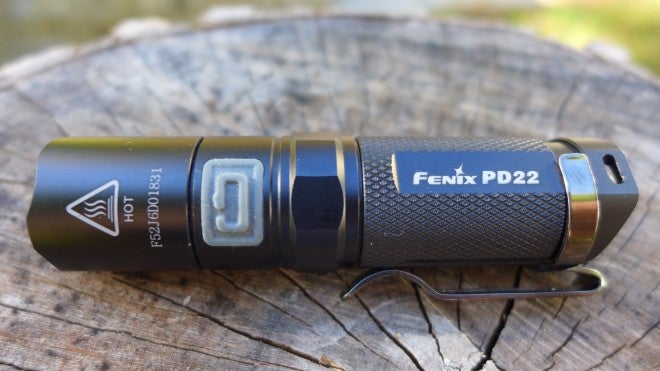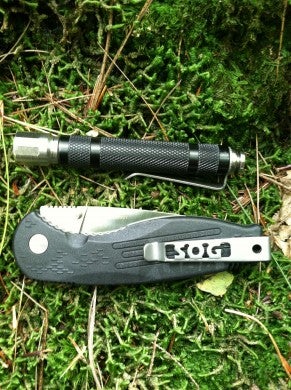The Flashlight UI Compendium, Part I
Tony Sculimbrene 10.14.13

Less than 20 years ago, the idea of a user interface on a flashlight would have been as foreign as the phrase “Google search.” Flashlights turned on and off. One mode. That was it. But times have thankfully changed, and flashlight technology has improved dramatically in two short decades.
We have lights that can be stuffed in your pocket that produce as many lumens as your car headlight. We have lights that run on tiny batteries and do so for days or even weeks. We have lights that can operate in candle mode for months. But all of this technology is still limited by one thing: the user interface. With the advent of computer controlled emitters and multimode outputs, the methods of accessing all of this power have blossomed. But not all of these flowers are worth picking. This three-part series will hopefully answer virtually every flashlight UI question you could possibly have.
Why Many Modes?
All of this discussion of UI suggests a simple question: why do flashlights need modes anyway? People got along perfectly fine for 70 or so years with single-mode flashlights, and there are still many out there today that sell and work quite well.
The reality is that multiple modes better accommodate how people use lights and help conserve power. You don’t need 1,000 lumens on the way to the John in the middle of the night, and you need more than a flickering candle can produce when you’re trying to see what it is at the end of your driveway that’s making all that noise as you’re trying to fall asleep. These tasks require different light levels, and different modes allow you to get those different levels in the same light.
Before flashlights came with small microprocessors that could regulate output, it was virtually impossible to get different modes. Now, with these tiny computers on board, you can do all sorts of things that give you different performances from the same light. The trade off is, as always, runtime versus brightness. With microprocessing regulation, you can switch from emphasizing one to emphasizing the other all with the same light.
Kinds of Modes
So now that you understand why there are different modes, it might be helpful to know what they are.
Generally, flashlights have two kinds of modes: general modes and specialty modes. General modes consist of constant illumination in varying outputs. Specialty modes allow the light to act as a blinding device by using strobing effects, to act as a beacon by turning off and on automatically at a specified rate, or to turn off and on in Morse code, sending out an SOS with light.
The specialty modes sound handy, but generally they’re a pain in the butt. Think of them as your spare tire in your car. It is useful about 1% of the time, but in that 1% of the time it is crucial. Generally, I prefer lights without these modes, but I can see why people want them. If the light does come with specialty modes, they should be hidden or out of the way of the main modes. You’d hate to blind your significant other when all you were trying to do is find your glasses in the dark.
Sequencing and Spacing
So what is the ideal sequence for the modes? Generally there are two setups: the EDC setup and the tactical setup. The EDC setup has the light come on in low. This is an acknowledgement that you need just a little bit of light the vast majority of the time. In fact, if you keep track as an experiment, you’ll quickly find out that you use the highest output very infrequently and usually only for fun.
The tactical setup has the light come on in high. This very useful if you have the illuminate the entire side of a building or if you are trying to disorient an opponent (or so the product literature claims, I have no tactical experience at all and hate that word, so I will have to take SureFire’s claims as true). Some lights come on in medium and then drop to low or jump to high, but these are more rare.
I’d always prefer the EDC setup as high output is the least used output with the easy to remember sequencing of L-M-H. I’d also prefer the low to be very low – something like 1-5 lumens – as this is enough to light your way in the dark without blowing your night vision.
The medium should be, in my opinion, between 30-50 lumens, which is plenty for most tasks. After that I’d like the high to be full power for as long as possible. Some lights, like the NexTorch and the uber rare Indium, allow you to program the output levels. This is nice, but probably a little more geekery than is necessary (and yes, I am aware that all of this is geekery). Also, like movable shelves on bookcases, you’ll probably never reset them more than once or twice. Good preset outputs are fine.
Mode Memory
The next thing you might want in a light is mode memory. Mode memory means that the light comes on in the last used mode. Generally mode memory will skip strobe modes or the like and come in the last regular mode. This is very handy as it essentially allows you to pick the order in which the light cycles through the modes and allows you to pick the starting mode. If you want the light to start in low, turn it off in low. If you want it to start in medium, turn it off in medium. This also means that the order of modes is user controllable to a certain extent. By starting in medium, you change the order of modes from L-M-H to M-H-L. Memory mode is tremendously helpful and worth the increased cost.
Hidden Modes
Hidden modes are also helpful. I prefer lights without strobe or SOS modes, but very few other people do. Still, dropping into strobe on the trip to the bathroom in the middle of the night is not a good thing… for your marriage. So lots of makers hide the strobe and SOS modes in the UI, requiring you to cycle through the modes in rapid succession a couple of times or use unusual button presses to find these specialty modes.
I like hidden modes as a next best thing to not having specialty modes at all, but I have found that certain user interfaces make it harder to get to hidden modes than others. Clickies do very well with hidden modes because of their distinctive tactile and auditory feedback, while twisties and selector rings do poorly because of the lack of feedback. You should think long and hard about whether or not you need these specialty modes. If you do, you’ll be glad they are hidden – or at least your significant other will.
Momentary On
Finally, momentary on is something you need to consider. Momentary on is, according to tactical flashlight literature, very important. They claim it can blind people and give “operators” quick access to light. I find this claim kind of silly because the difference in time between a half press and full press of a clicky on a flashlight is maybe a hundredth of a second.
In terms of EDC use, I have found that it is only moderately helpful, and then only when it is implemented correctly.
Generally, clicky user interfaces allow you to do a half press to get the light to come on (forward clickies only, more on that next time). This gives you a short burst of light, usually in the highest setting. It is good if you need to get a snapshot of a scene, like if you are checking your garbage cans for raccoons (or foxes, like in my neighborhood, those things sound like Satan’s bloodhounds). The time savings, again is silly, but the fact that the light is not turned on makes it less likely that you forget and leave it on.
Momentary on is a nice, but hardly essential on an EDC flashlight. I have found the momentary on on the Peak Eiger with QTC quite nice:
Next up I’ll run through the first half of flashlight UIs.
